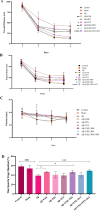Moderate aerobic training enhances the effectiveness of insulin therapy through hypothalamic IGF1 signaling in rat model of Alzheimer's disease
- PMID: 38987609
- PMCID: PMC11237031
- DOI: 10.1038/s41598-024-66637-2
Moderate aerobic training enhances the effectiveness of insulin therapy through hypothalamic IGF1 signaling in rat model of Alzheimer's disease
Abstract
Alzheimer's disease (AD) is a neurological condition that is connected with a decline in a person's memory as well as their cognitive ability. One of the key topics of AD research has been the exploration of metabolic causes. We investigated the effects of treadmill exercise and intranasal insulin on learning and memory impairment and the expression of IGF1, BDNF, and GLUT4 in hypothalamus. The animals were put into 9 groups at random. In this study, we examined the impact of insulin on spatial memory in male Wistar rats and analyzed the effects of a 4-week pretreatment of moderate treadmill exercise and insulin on the mechanisms of improved hypothalamic glucose metabolism through changes in gene and protein expression of IGF1, BDNF, and GLUT4. We discovered that rat given Aβ25-35 had impaired spatial learning and memory, which was accompanied by higher levels of Aβ plaque burden in the hippocampus and lower levels of IGF1, BDNF, and GLUT4 mRNA and protein expression in the hypothalamus. Additionally, the administration of exercise training and intranasal insulin results in the enhancement of spatial learning and memory impairments, the reduction of plaque burden in the hippocampus, and the enhancement of the expression of IGF1, BDNF, and GLUT4 in the hypothalamus of rats that were treated with Aβ25-35. Our results show that the improvement of learning and spatial memory due to the improvement of metabolism and upregulation of the IGF1, BDNF, and GLUT4 pathways can be affected by pretreatment exercise and intranasal insulin.
Keywords: Alzheimer’s disease; Insulin; Metabolism; Spatial learning and memory; Treadmill exercise.
© 2024. The Author(s).
Conflict of interest statement
The authors declare no competing interests.
Figures








References
MeSH terms
Substances
LinkOut - more resources
Full Text Sources
Medical
Miscellaneous

